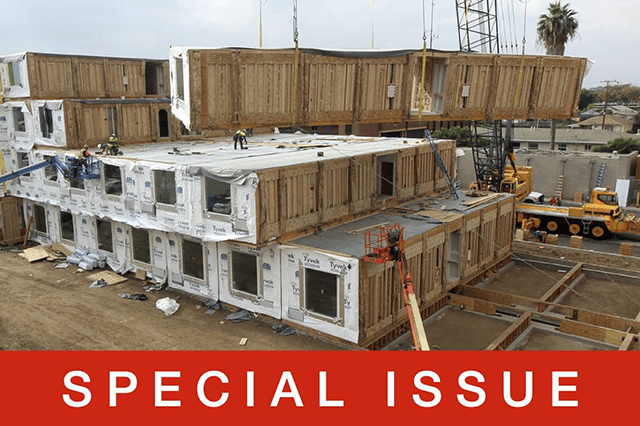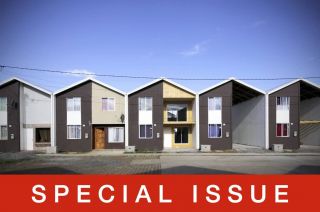
www.buildingsandcities.org/journal-content/special-issues/modern-methods-construction.html
Modern Methods of Construction: Beyond Productivity Improvement

This special issue investigates the broader implications and consequences of MMC over the life of the building - for both civil society and the construction industry.
Modern methods of construction (MMC) are being promoted as a solution to the perceived failings of the construction sector. The narrative is notably characterised by a strong pro-innovation bias. This special issue examines the assumptions underpinning the prevailing 'presumption in favour' of MMC. Evidence is offered about the externalities which lie beyond the narrowly-defined construct of productivity.
Guest editor: Stuart D. Green
Very little evidence exists on the implications of MMC for the material fabric of the built environment. There is also a recurring reluctance to investigate and learn the lessons from previous attempts at the industrialisation of construction. This is of particular concern within the context of housing, although it applies equally to other sectors. A lack of data exists on the implications of MMC for the performance and longevity of buildings, and their ability to respond over time to shifting societal and occupant needs. The durability and adaptability of buildings are of central importance for resource consumption and for the achievement of a net-zero carbon economy. Further concerns relate to environmental performance and occupant wellbeing. Even more importantly, significant concerns remain regarding the implications of MMC for fire safety.
This special issue initiates an important discussion about MMC in its various forms (pre-manufactured value, offsite, industrialised construction, etc). In particular, whether the existing evidence base and research focus have been too narrow and need to be broadened in order to better understand and evaluate the implications of MMC. Is the research community investigating the appropriate questions about MMC and pursuing the interests of wider society? Is the current regulatory regime adequate to identify and reduce new risks?
The safety of the building in use and the potential risks to occupants are vital issues. Meacham's paper focuses on the fire performance and regulatory considerations associated with MMC. He argues that the adoption of MMC presents challenges to traditional building regulatory approaches. Particular attention is focused on the void spaces between prefabricated components, and especially those that exist between prefabricated modules. This paper deserves to be read widely, and its recommendations need to be actioned.
Dowsett et al. take a broad interpretation of MMC as comprising one of many possible constituent technologies of the Fourth Industrial Revolution. They argue that current debates are often dominated by notions of top-down 'technological prediction'. Instead, they offer a co-creation approach using scenario-planning rooted in the tradition of storytelling. This is used to explore how technologies are likely to play out in a highly heterogeneous construction sector. They especially privilege the views of small and medium-sized enterprises (SMEs) which are held to be more representative of the construction sector than tier 1 contractors. A useful methodology is provided for structuring a much broader and more realistic debate about the future role of technologies in construction.
Table of Contents
Modern methods of construction: reflections on the current research agenda
S.D. Green
Fire performance and regulatory considerations
with modern methods of construction
B.J. Meacham
Speculation beyond technology: building scenarios through
storytelling
R.M. Dowsett, M.S. Green & C.F. Harty
Commentaries
The Need for a 'Critical Turn' in Construction Management Research
R Leiringer & A Dainty
Modernize and Die? Challenging Technological Optimism in Construction
F. Sherratt
Situating MMC within Technological Adoption
G. de Valence
Modern methods of construction: unintended consequences
S.D. Green
Critical reflections on the Construction Playbook
S.D. Green
A history of failed dreams: modern methods of construction and Katerra
A. Rabeneck
Latest Peer-Reviewed Journal Content
Acceptability of sufficiency consumption policies by Finnish households
E Nuorivaara & S Ahvenharju
Key factors for revitalising heritage buildings through adaptive reuse
É Savoie, J P Sapinski & A-M Laroche
Cooler streets for a cycleable city: assessing policy alignment
C Tang & J Bush
Understanding the embodied carbon credentials of modern methods of construction
R O'Hegarty, A McCarthy, J O'Hagan, T Thanapornpakornsin, S Raffoul & O Kinnane
The changing typology of urban apartment buildings in Aurinkolahti
S Meriläinen & A Tervo
Embodied climate impacts in urban development: a neighbourhood case study
S Sjökvist, N Francart, M Balouktsi & H Birgisdottir
Environmental effects of urban wind energy harvesting: a review
I Tsionas, M laguno-Munitxa & A Stephan
Office environment and employee differences by company health management certification
S Arata, M Sugiuchi, T Ikaga, Y Shiraishi, T Hayashi, S Ando & S Kawakubo
Spatiotemporal evaluation of embodied carbon in urban residential development
I Talvitie, A Amiri & S Junnila
Energy sufficiency in buildings and cities: current research, future directions [editorial]
M Sahakian, T Fawcett & S Darby
Sufficiency, consumption patterns and limits: a survey of French households
J Bouillet & C Grandclément
Health inequalities and indoor environments: research challenges and priorities [editorial]
M Ucci & A Mavrogianni
Operationalising energy sufficiency for low-carbon built environments in urbanising India
A B Lall & G Sethi
Promoting practices of sufficiency: reprogramming resource-intensive material arrangements
T H Christensen, L K Aagaard, A K Juvik, C Samson & K Gram-Hanssen
Culture change in the UK construction industry: an anthropological perspective
I Tellam
Are people willing to share living space? Household preferences in Finland
E Ruokamo, E Kylkilahti, M Lettenmeier & A Toppinen
Towards urban LCA: examining densification alternatives for a residential neighbourhood
M Moisio, E Salmio, T Kaasalainen, S Huuhka, A Räsänen, J Lahdensivu, M Leppänen & P Kuula
A population-level framework to estimate unequal exposure to indoor heat and air pollution
R Cole, C H Simpson, L Ferguson, P Symonds, J Taylor, C Heaviside, P Murage, H L Macintyre, S Hajat, A Mavrogianni & M Davies
Finnish glazed balconies: residents' experience, wellbeing and use
L Jegard, R Castaño-Rosa, S Kilpeläinen & S Pelsmakers
Modelling Nigerian residential dwellings: bottom-up approach and scenario analysis
C C Nwagwu, S Akin & E G Hertwich
Mapping municipal land policies: applications of flexible zoning for densification
V Götze, J-D Gerber & M Jehling
Energy sufficiency and recognition justice: a study of household consumption
A Guilbert
Linking housing, socio-demographic, environmental and mental health data at scale
P Symonds, C H Simpson, G Petrou, L Ferguson, A Mavrogianni & M Davies
Measuring health inequities due to housing characteristics
K Govertsen & M Kane
Provide or prevent? Exploring sufficiency imaginaries within Danish systems of provision
L K Aagaard & T H Christensen
Imagining sufficiency through collective changes as satisfiers
O Moynat & M Sahakian
US urban land-use reform: a strategy for energy sufficiency
Z M Subin, J Lombardi, R Muralidharan, J Korn, J Malik, T Pullen, M Wei & T Hong
Mapping supply chains for energy retrofit
F Wade & Y Han
Operationalising building-related energy sufficiency measures in SMEs
I Fouiteh, J D Cabrera Santelices, A Susini & M K Patel
Promoting neighbourhood sharing: infrastructures of convenience and community
A Huber, H Heinrichs & M Jaeger-Erben
New insights into thermal comfort sufficiency in dwellings
G van Moeseke, D de Grave, A Anciaux, J Sobczak & G Wallenborn
'Rightsize': a housing design game for spatial and energy sufficiency
P Graham, P Nourian, E Warwick & M Gath-Morad
Implementing housing policies for a sufficient lifestyle
M Bagheri, L Roth, L Siebke, C Rohde & H-J Linke
The jobs of climate adaptation
T Denham, L Rickards & O Ajulo
Structural barriers to sufficiency: the contribution of research on elites
M Koch, K Emilsson, J Lee & H Johansson
Disrupting the imaginaries of urban action to deliver just adaptation [editorial]
V Castán-Broto, M Olazabal & G Ziervogel
Nature for resilience reconfigured: global- to-local translation of frames in Africa
K Rochell, H Bulkeley & H Runhaar
How hegemonic discourses of sustainability influence urban climate action
V Castán Broto, L Westman & P Huang
Fabric first: is it still the right approach?
N Eyre, T Fawcett, M Topouzi, G Killip, T Oreszczyn, K Jenkinson & J Rosenow
Social value of the built environment [editorial]
F Samuel & K Watson
Understanding demolition [editorial]
S Huuhka
Data politics in the built environment [editorial]
A Karvonen & T Hargreaves



Latest Commentaries
Decolonising Cities: The Role of Street Naming
During colonialisation, street names were drawn from historical and societal contexts of the colonisers. Street nomenclature deployed by colonial administrators has a role in legitimising historical narratives and decentring local languages, cultures and heritage. Buyana Kareem examines street renaming as an important element of decolonisation.
Integrating Nature into Cities
Increasing vegetation and green and blue spaces in cities can support both climate change mitigation and adaptation goals, while also enhancing biodiversity and ecological health. Maibritt Pedersen Zari (Auckland University of Technology) explains why nature-based solutions (NbS) must be a vital part of urban planning and design.